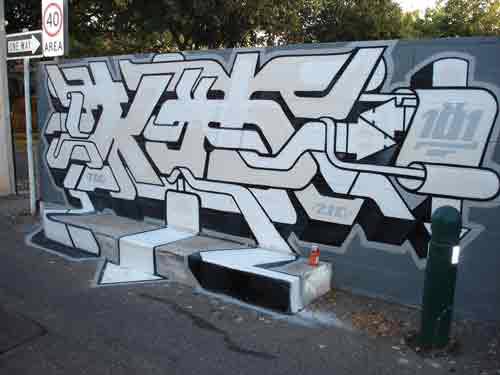.jpg)
It's hard to recall a time when the popular and critical presence of street art was not naturally included in discussions about the operations of today’s visual culture. The last decade certainly has borne witness to an institutional acceptance, if not of its formal, stylistic contribution to the visual arts, then at the very least to its widespread and literal visibility within public space.
Significant exhibitions such as Street Art at Tate Modern in 2008 and Art in the Streets at the Museum of Contemporary Art Los Angeles in 2011 have only endorsed a growing interest in street art as a credible visual movement and not a criminal tendency and so, Rafael Schacter’s World Atlas of Street Art and Graffiti proves a timely contribution to these discussions about the role and value of this particular style of art. Schacter in fact curated the Tate Modern exhibition and as an anthropologist, curator and writer he is as well-placed as any to contemplate the ambitious task he sets himself with this book.
In his introduction, Schacter frames our current understandings of street art as something that emerged from the East Coast of the United States in the late 1960s, but in referring to the huge scope of works that features across this 400-page tome, Schacter consciously employs a singular umbrella term that was coined originally by academic Javier Abarca - Independent Public Art. It is extraordinary how this simple shift in semantics automatically broadens the critical parameters for considering and receiving this work as a formal piece of visual art and not just a socio-cultural phenomenon.
Tagging, murals, sculptures, public interventions, posters, paintings, projections, stencils and much else here is deliberately and formally considered in terms of its concept, execution, influence, style, and the artistic development of the artist.
Structurally the book offers a numbers of entry points. It is loosely divided into five sections - North America, Latin America, Northern Europe, Southern Europe and the Rest of the World (meaning: Sydney, Melbourne and Tokyo).
Within this, sixteen cities are specifically profiled by local experts and within this, numerous artists who have had some connection or made some contribution to the city also feature. In total, there are 113 artists or collectives from 25 different countries. It’s necessarily subjective, with locations chosen by virtue of historical and contemporary relevance, distinctiveness and having a critical mass of artists. It is a shame that other parts of the world (namely Africa and Asia) are not accounted for given it purports to be a 'World Atlas’, if for no other reason than to offer further context for that already put forward. Gang graffiti, gallery and institutionally commissioned work and protest art are also not addressed, keeping the focus solely on contemporary artists producing independent works of public facing art. And there are a lot of those.
The World Atlas is dense with images that genuinely surprise with their wit, poignancy, audacity and scale. From the work of doctor and documentary photographer Jetsonorama, working on a Navajo reservation in Arizona; to the photographs of Italian Filippo Minelli, capturing the evanescing coloured gas of smoke bombs being set off in the middle of deserted landscapes; to the Merz-inspired sculptures of Berlin-based Clemens Behr. In each artist profile, Schacter articulates the relevant art historical debts, from Pop Art to Land Art, Mexican muralism to Italian Arte Povera and his profiles are succinct and effective summaries of practice and work to date.
At times however, Schacter does not make clear the connection between the artist and the city. Unfortunately it is frequently confusing, but in some respects can probably be considered reflective of the itinerant, ephemeral nature of much of this work and the transience of its makers. For instance the artist Aryz, who paints exquisite, large-scale romantic murals, features in the section on Barcelona, despite being born in California, but the images are of works made in Poland, Denmark and Italy, with just one work in Catalunya.
With an Australian-focused foreword by Chris Johnston, and a work by Anthony Lister on the cover, this edition places Australian street artists naturally as part of the international discussion and works by twenty Australians, including Buff Diss, Meggs, Lister, Ben Frost and Ian Strange feature.
The World Atlas of Street Art and Graffiti is a dense, beautiful book with a lot to recommend it and as a critical guide to the formal aesthetics of a lot of street art happening around the world, it brings a welcome criticality and aesthetic seriousness to the current discussion on street art and graffiti practices.












